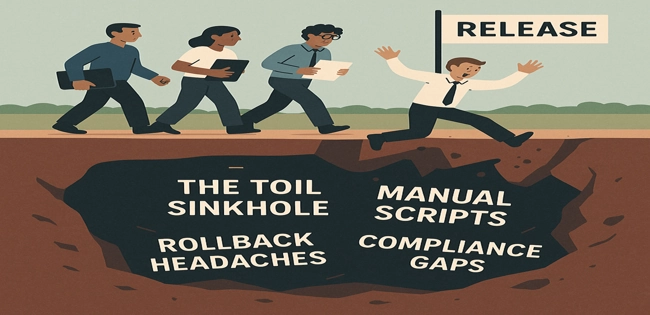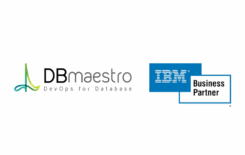Software is never static. Agile teams push changes to production multiple times a day. Features evolve fast, business needs pivot even faster – and at the heart of it all lies the one constant that can either drive or derail your success: the database.
Unfortunately, for most organizations, the database hasn’t caught up with the pace of DevOps. While applications move with speed and agility, databases are bogged down by manual, error-prone, and risk-laden processes. That burden is known as database toil – and it’s more costly than most IT leaders realize.
Let’s break down what this toil looks like, why it’s dangerous, and how to eliminate it for good.
🧱 What Is Database Toil?
In DevOps, “toil” refers to repetitive, manual work that’s automatable and adds little long-term value. Database toil is the set of ongoing manual tasks required to manage schema changes, enforce governance, prevent drift, and align database states across environments.
These tasks aren’t just annoying – they’re dangerous. They lead to:
- Release delays
- Production outages
- Compliance violations
- Skyrocketing costs
And worst of all? They scale with your system, not your strategy.

🔍 The Core Elements of Database Toil
Let’s walk through the primary components of database toil and why they matter to your business.
1. Manual Script Management
Most database changes today begin with developers or DBAs hand-writing SQL scripts. These scripts govern everything from adding new columns to changing constraints or altering procedures.
Why it’s toil:
- Every script needs review, approval, and testing
- One mistake (like missing a WHERE clause) can bring down production
- You’re reinventing the wheel for every change
Risks:
- Delays: Scripts wait in queues for DBA reviews
- Errors: Manual mistakes slip through
- Inconsistency: Teams write changes differently, leading to chaos
Example: Imagine three development teams working on the same schema. One adds a column, another drops a deprecated index, the third changes a datatype. Without coordination, these scripts may collide – creating outages, rollbacks, and lost development time.
2. Environment Drift
In theory, dev, test, and production databases should look identical. In practice, they drift – quickly.
Why it’s toil:
- Drift happens when a change hits one environment but not another
- Most teams detect drift manually (or worse, during an outage)
Risks:
- Bugs: QA passes a feature, but it fails in production
- Production instability: Hotfixes applied directly to prod never make it back to dev
- Hidden costs: Engineering time wasted debugging “it worked on my machine” problems
3. Manual Deployments
Even if your application code is fully automated with CI/CD pipelines, the database often gets deployed manually. That creates a fragile handoff that breaks delivery flow.
Why it’s toil:
- DBAs manually execute scripts or follow step-by-step Word docs
- Coordination is needed with multiple teams (QA, security, release)
Risks:
- Downtime: Delayed deployment = missed SLAs
- Rollback nightmares: If a change fails, there’s no “undo” button
- Blocked releases: Teams must wait for DBA availability
4. Audit & Compliance Overhead
If your organization is subject to SOX, GDPR, HIPAA, or internal audit requirements, tracking who made which change, why, and when isn’t optional.
Why it’s toil:
- Audit trails are manually maintained in spreadsheets or ticketing systems
- Changes require multi-step approvals and email chains
Risks:
- Compliance fines: Missing documentation or improper approvals
- Business risk: No visibility into unapproved or rogue changes
- Executive blind spots: Inability to report or explain past changes when needed
5. Rollback & Recovery
Application teams can often roll back code by reverting a commit. For databases, rolling back means manually writing an “undo” script – and praying it works.
Why it’s toil:
- Every rollback is custom
- Recovery is reactive, often in high-stress moments
Risks:
- Downtime: Recovery can take hours
- Data loss: Schema changes often include irreversible data changes
- Customer impact: Poor incident response damages trust and revenue
6. Collaboration Silos
Database changes are typically treated as “sensitive,” meaning only DBAs can handle them. Meanwhile, developers are left in the dark.
Why it’s toil:
- Creates bottlenecks
- Limits agility
- Encourages workarounds (e.g., bypassing processes to “just get it done”)
Risks:
- Poor accountability: No one owns the change end-to-end
- Slower time to market: Database becomes the bottleneck in every release
- Low morale: Frustration builds when innovation is slowed
🧨 The Consequences of Ignoring Database Toil
If you don’t address database toil, you will feel the impact – not just in IT, but across the business:
| Consequence | Description |
| Slower Releases | Manual reviews and approvals delay sprints |
| Increased Downtime | Mistakes during manual deployments lead to outages |
| Compliance Gaps | Manual logs and approvals don’t stand up to audits |
| Developer Burnout | Waiting on DBAs kills momentum and morale |
| Lost Revenue | Every delayed or failed feature is a missed business opportunity |
🚀 Enter DBmaestro: From Toil to Flow
Now that we’ve diagnosed the problem, let’s talk about the cure.
DBmaestro is a database DevSecOps automation platform built to eliminate database toil from end to end. It integrates with your DevOps toolchain to make database changes as smooth, safe, and fast as application code changes.
Here’s how:
- Pipeline-Ready Database Automation
DBmaestro turns database changes into version-controlled, pipeline-ready artifacts. Developers commit changes via Git, just like code.
- Impact: No more manual script handoffs
- Result: Developers and DBAs speak the same language
Example: A developer commits a schema change, which DBmaestro automatically validates, tests, and promotes through staging to production – all with proper approvals.
- Drift Prevention & Environment Sync
DBmaestro tracks schema differences between environments and prevents changes that introduce drift.
- Impact: Confidence that dev, test, and prod are aligned
- Result: No more “worked in staging” surprises
- Audit, Approvals & Compliance – Built-In
DBmaestro captures every change, approval, and action with full traceability.
- Impact: Always audit-ready
- Result: Avoid compliance risks without extra effort
Bonus: Approvals can be tied to JIRA tickets or ITSM workflows – so changes only proceed when governance criteria are met.
- Safe Rollbacks
DBmaestro enables rollback automation by versioning database states and allowing safe undo of unwanted changes.
- Impact: Outage recovery in minutes, not hours
- Result: Minimized customer impact and reduced downtime costs
- Real Observability
Using metadata and DORA-aligned metrics, DBmaestro offers deep insights into your release velocity, change failure rate, and environment health – specifically for the database.
- Impact: Make data-driven decisions
- Result: Know where bottlenecks are and how to fix them
- Collaboration & Control
DBmaestro empowers dev teams while keeping DBAs in control. It supports role-based access, separation of duties, and policy enforcement.
- Impact: Shared responsibility without chaos
- Result: Move fast, stay safe
📈 The Business Impact
Eliminating database toil isn’t just a technical win – it’s a business accelerator.
| Benefit | Business Outcome |
| Faster Time to Market | Launch new features sooner |
| Reduced Downtime | Protect revenue and reputation |
| Higher Developer Productivity | Build more with the same team |
| Stronger Compliance Posture | Avoid fines and pass audits |
| Improved Cross-Team Collaboration | Break silos, streamline delivery |
🎯 Final Thought: Toil Is a Choice – Automation Is the Way Forward
Application DevOps has already proven its worth. Now it’s the database’s turn.
Database toil doesn’t scale, doesn’t innovate, and doesn’t win markets. The longer you allow it to persist, the more friction, risk, and cost you absorb into your delivery pipeline.
With DBmaestro, you can flip the script – turn manual chaos into structured automation, eliminate bottlenecks, and unlock a higher-performing business.
Your apps are agile. Your database should be too.






